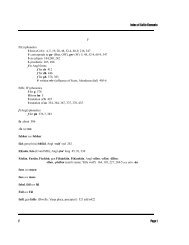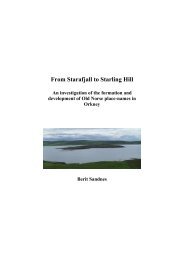May Williamson: The Non-Celtic Place-Names of the Scottish Border ...
May Williamson: The Non-Celtic Place-Names of the Scottish Border ...
May Williamson: The Non-Celtic Place-Names of the Scottish Border ...
You also want an ePaper? Increase the reach of your titles
YUMPU automatically turns print PDFs into web optimized ePapers that Google loves.
32<br />
CADDONLEE (Cad):<br />
Cadanly, Blaeu. <strong>The</strong> first element is Caddon, a <strong>Celtic</strong> river-name (CPNS, 431).<br />
CROSSLEE (Ettr):<br />
Corslie, 1766 C-B. An ancient cross has been found in <strong>the</strong> vicinity, from which <strong>the</strong> place no<br />
doubt took its name.<br />
FAIRNILEE (Cad): (80, 11 D):<br />
Farnyle(y), 1405 Rot Scac; 1455 ib; Fairnilee, 1599 L Ch. OE færnige-lēah, “ferny glade”.<br />
For <strong>the</strong> modern spelling <strong>of</strong> <strong>the</strong> first element, compare Fairnington (MSc ai = [E]).<br />
INNER and OUTER HUNTLY (Krk): (80, 10 G):<br />
Hunteleghe, 1296 CDS; Huntlie, 1494 C-B. “Wood for hunting”: cf Huntley, Glo (DEPN,<br />
246).<br />
SINGLIE (Krk): (80, 8 H): /78/<br />
Senglee, 1368 LSMM; Seyngillie, 1494 C-B; Synglie, 1511 RMS; Singill E, Blaeu. Compare<br />
Singdean (Cst): Singdenn, Blaeu. <strong>The</strong> first element may be ModSc sing, a form <strong>of</strong> “singe”<br />
(Jam, s.v.).<br />
“Lost” names are:<br />
Arkilly, c 1200 (16 th ) Dryb, described as “longas fossas”, near Fans (Earl), which contains ME<br />
Arkil, from ODan Arnkell.<br />
Blyndle, 1455 Rot Scac; Blindley, 1543 RSS, in Gala, denotes a clearing in a concealed<br />
position.<br />
Eadwardsle, 1165-1214 NMS; Edwordisley, 1147-52 (Morton) ESC, is OE Ēadwærdes lēah.<br />
This may have been <strong>the</strong> spot where Edward, son <strong>of</strong> William Rufus, died in 1093 on a <strong>Scottish</strong><br />
campaign. A field-name, Long Edwardley, SE <strong>of</strong> Jedburgh preserves this form (Watson, Jed,<br />
47).<br />
Flaxillis, c 1220 Dryb; Flexwelleys, c 1350 ib, in Berwickshire, is “flax-well-lees”.<br />
Schotynle, 1423 RMS; Schutynle, ib; Schuittingleyes, 1573 C-B, near Glengaber (Yar),<br />
denotes a place where shooting contests were held.<br />
<strong>The</strong>re are forty o<strong>the</strong>r names ending in -lee.<br />
/79/ XIX OE feld,<br />
“open country, land free from wood, unenclosed land”, is particularly common in old forest<br />
districts in England. It probably denoted an open space <strong>of</strong> larger extent than a lēah (DEPN,<br />
169).<br />
In our area feld does not appear to be one <strong>of</strong> <strong>the</strong> earliest endings; indeed none <strong>of</strong> <strong>the</strong> names<br />
seems to be earlier than ME. In Nb, however, several may belong to <strong>the</strong> OE period.




